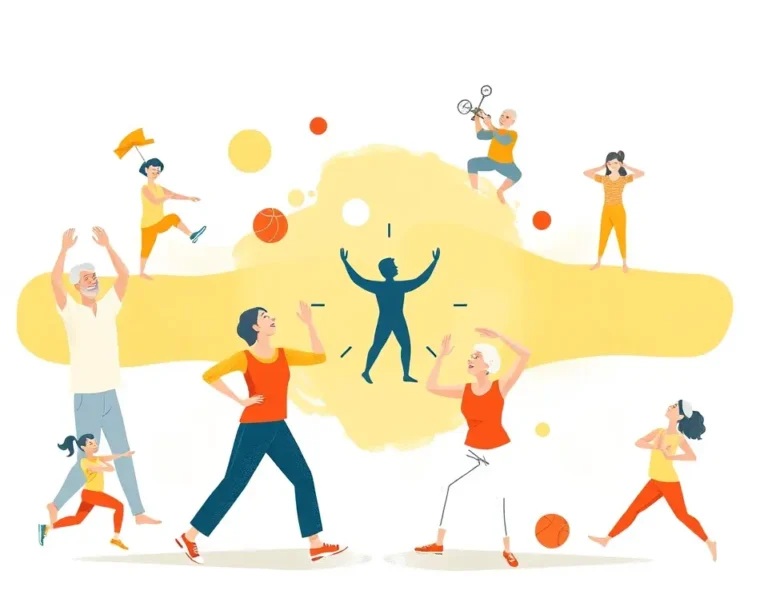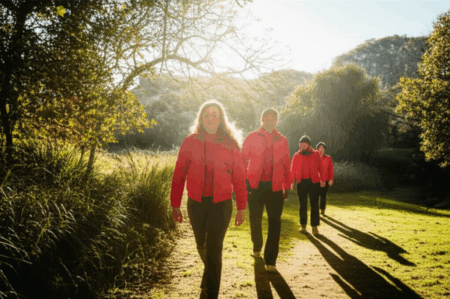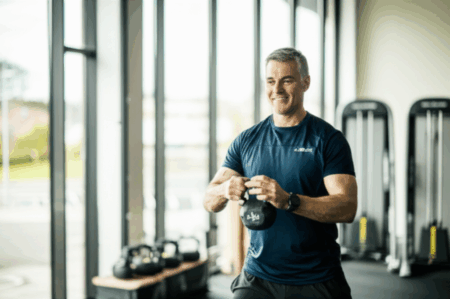While the popular 10,000-step goal promotes an active lifestyle, relying solely on walking may not suffice to maintain optimal fitness after 60. Integrating varied exercises becomes crucial to address age-related physiological changes, according to fitness experts. This article explores why diversifying your fitness routine is essential and suggests four exercises to incorporate for a holistic approach to health and well-being.
The Limitations of Solely Walking 10,000 Steps
Walking is undeniably beneficial, offering numerous advantages such as improved cardiovascular health, mental agility, and joint health. A study found that women over 63 who walked approximately 3,600 steps daily reduced their risk of heart failure by 26%. It’s a low-impact activity suitable for almost everyone, promoting better circulation, stronger muscles, and healthy weight management. However, as we age, our bodies undergo changes that require a more comprehensive fitness strategy.
Addressing Age-Related Changes
After 60, muscle mass and strength naturally decline, a condition known as sarcopenia. Walking alone may not provide sufficient stimulus to combat this muscle loss. Additionally, balance, flexibility, and bone density can diminish, increasing the risk of falls and fractures. A well-rounded fitness plan should incorporate exercises that target these specific areas.
The Need for a Holistic Approach
Relying solely on walking may lead to neglecting other vital aspects of fitness, such as:
- Strength: Essential for maintaining independence, performing daily tasks, and preventing falls.
- Balance: Crucial for stability and coordination, reducing the risk of accidents.
- Flexibility: Improves range of motion, reduces stiffness, and prevents injuries.
Four Essential Exercises to Complement Walking
To ensure comprehensive fitness after 60, consider incorporating these four types of exercises into your routine:
1. Strength Training
Strength training is vital for combating muscle loss and maintaining overall functionality. It involves using resistance to contract muscles, which can be achieved through bodyweight exercises, weights, or resistance bands.
Benefits of Strength Training
- Combats Sarcopenia: Strength training helps prevent and even reverse age-related muscle loss. A 2024 study shows that older adults can prevent and even reverse sarcopenia with progressive strength training.
- Increases Bone Density: Weight-bearing exercises stimulate bone growth, reducing the risk of osteoporosis and fractures.
- Enhances Metabolism: Muscle tissue burns more calories than fat tissue, boosting metabolism and aiding in weight management.
- Improves Balance and Coordination: Stronger muscles improve stability and reduce the risk of falls.
- Boosts Energy Levels: Regular strength training can increase energy and reduce fatigue.
Strength Training Exercises for Seniors
- Squats: Can be modified using a chair for support.
- Stand with your feet shoulder-width apart, and toes slightly turned out.
- Lower your hips as if sitting in a chair, keeping your back straight and chest lifted.
- Ensure your knees don’t extend past your toes.
- Push through your heels to return to a standing position.
- Aim for 3 sets of 10 repetitions.
- Wall Push-Ups: A gentler alternative to traditional push-ups.
- Stand facing a wall, arms extended, and hands shoulder-width apart.
- Lean towards the wall, bending your elbows until your chest almost touches the wall.
- Push back to the starting position.
- Aim for 3 sets of as many repetitions as comfortable.
- Dumbbell Rows: Strengthen back and arm muscles.
- Lean forward, supporting your body with one hand on a chair or table.
- Hold a dumbbell in the other hand, keeping your back straight.
- Pull the dumbbell up towards your chest, keeping your elbow close to your body.
- Lower the dumbbell slowly.
- Aim for 3 sets of 12-15 repetitions per arm.
- Bicep Curls: Can be done with light weights or water bottles.
- Stand or sit with your feet flat on the floor.
- Hold a weight in each hand, palms facing forward.
- Bend your elbows, bringing the weights towards your shoulders.
- Lower the weights slowly.
- Aim for 3 sets of 10 repetitions per arm.
- Tricep Dips: Use a chair or bench for support.
- Sit on the edge of a chair or bench, placing your hands on the edge with your fingers pointing forward.
- Slide your hips off the edge and lower your body by bending your elbows.
- Push back up to the starting position.
- Aim for 3 sets of as many repetitions as comfortable.
- Calf Raises: Strengthen calf muscles for better balance.
- Stand with your feet hip-width apart, holding onto a chair for support if needed.
- Raise up onto your toes, lifting your heels off the ground.
- Hold for a few seconds, then lower slowly.
- Aim for 3 sets of 15-20 repetitions.
- Progressive Strength Training Plans: A beginner plan focuses on bodyweight exercises or light weights, while intermediate and advanced plans incorporate light to moderate and moderate to heavy weights, respectively.
Tips for Starting Strength Training
- Start Slowly: Begin with light weights or bodyweight exercises and gradually increase the intensity as you get stronger.
- Focus on Proper Form: Ensure you target the right muscles and reduce the risk of injury.
- Listen to Your Body: Don’t push yourself to the point of pain.
- Warm-Up and Cool-Down: Prepare your body for exercise with light cardio and gentle stretches.
2. Balance Exercises
Balance exercises are essential for maintaining stability and preventing falls, a significant concern for older adults. They help improve coordination and strengthen the muscles responsible for balance.
Benefits of Balance Exercises
- Reduces Risk of Falls: Improves stability and coordination, lowering the likelihood of accidents.
- Enhances Proprioception: Heightens awareness of your body’s position in space.
- Strengthens Core Muscles: Core strength is crucial for maintaining balance.
- Improves Confidence: Feeling more stable can boost confidence and encourage greater physical activity.
Balance Exercises for Seniors
- Single Limb Stance: A simple exercise to start with.
- Stand behind a sturdy chair, holding onto the back for support.
- Lift one foot off the floor and balance on the other foot.
- Hold the position for as long as you can, gradually increasing the duration.
- Repeat on the other side.
- Aim to stand on one foot for up to a minute without holding onto the chair.
- Weight Shifts: Improve stability by shifting your weight.
- Stand with your feet hip-width apart.
- Shift your weight onto one foot, lifting the other foot slightly off the floor.
- Hold the position, then return to the center.
- Repeat on the other side.
- Heel-to-Toe Walking: Enhances coordination and stability.
- Walk in a straight line, placing the heel of one foot directly in front of the toes of the other foot.
- Focus on maintaining your balance as you walk.
- Flamingo Stand: Builds hip muscles and stabilizes your core.
- Stand with your feet shoulder-width apart and touch your hands to a wall.
- Raise your right leg up to your hip as though marching.
- Lower it and do the same for the left.
- Increase the difficulty by going a little faster or raising your legs higher.
- Repeat for both sides about 10 to 20 times.
- Tai Chi: Improves balance and makes you more stable and less likely to fall.
Tips for Starting Balance Exercises
- Use Support: Start by holding onto a chair or wall for support and gradually reduce your reliance on it.
- Focus on a Fixed Point: Looking at a stationary object can help maintain balance.
- Engage Your Core: Tightening your abdominal muscles can improve stability.
- Practice Regularly: Incorporate balance exercises into your daily routine for optimal results.
3. Flexibility Exercises
Flexibility exercises, also known as stretching, are crucial for maintaining range of motion, reducing stiffness, and preventing injuries. As we age, our muscles and joints tend to become less flexible, making daily tasks more difficult.
Benefits of Flexibility Exercises
- Improves Range of Motion: Allows you to move more freely and comfortably.
- Reduces Stiffness: Alleviates muscle tension and joint stiffness.
- Prevents Injuries: Increases muscle elasticity, reducing the risk of strains and sprains.
- Enhances Posture: Improves body alignment and reduces back pain.
- Promotes Relaxation: Stretching can help relieve stress and tension.
Flexibility Exercises for Seniors
- Neck Stretches: Improve neck mobility and flexibility.
- Gently tilt your head to the left, right, forward, and backward.
- Hold each stretch for 15-30 seconds.
- Shoulder Rolls: Reduce stiffness and improve shoulder mobility.
- Roll your shoulders backward and forward in a slow, controlled motion.
- Wrist Flexor and Extensor Stretch: Promotes wrist mobility and alleviates wrist discomfort.
- Extend one arm in front of you with the palm facing up and gently pull the fingers back with your opposite hand.
- Then, flip your hand so the palm faces down and gently press the fingers toward your body.
- Switch arms and repeat.
- Calf Stretch: Loosens tight calf muscles.
- Place your hands against a wall for stability.
- Bend the right leg and step the left leg back at least a foot’s distance, keeping it straight.
- Both feet should be flat on the floor.
- Seated Knee to Chest: Improves hip mobility and eases lower back discomfort.
- Sit comfortably on your chair with your legs bent.
- Bring your right knee upward, grab it with both hands, and pull it slowly up toward your chest as far as it can comfortably go.
- Hold the position for 10 to 30 seconds, then guide the leg back down to the floor.
- Switch feet and do the same on the other side.
- Overhead Side Stretch: Sitting tall in a chair, raise your arms overhead and lean to the left, and hold yourself there for 10 to 30 seconds. Return to center, then do the same on the other side.
- Seated Torso Stretch: Sitting tall in a chair, cross your arms over your chest and twist towards your right as much as you can, trying to rotate only your torso while keeping your bottom on the chair. Hold this twist for 10 to 30 seconds. Return to center, then do the same on the other side.
Tips for Starting Flexibility Exercises
- Warm-Up First: Do some light cardio to warm up your muscles before stretching.
- Stretch Gently: Avoid bouncing or forcing the stretch.
- Hold Each Stretch: Hold each stretch for 15-30 seconds.
- Breathe Deeply: Relax and breathe deeply while stretching.
- Stretch Regularly: Aim to stretch at least 2-3 times per week.
4. Cardiovascular Exercise (Beyond Walking)
While walking is a great form of cardiovascular exercise, incorporating other activities can provide additional benefits and prevent monotony.
Benefits of Cardiovascular Exercise
- Improves Heart Health: Strengthens the heart muscle and improves circulation.
- Boosts Energy Levels: Increases endurance and reduces fatigue.
- Aids Weight Management: Burns calories and helps maintain a healthy weight.
- Reduces Risk of Chronic Diseases: Lowers the risk of heart disease, stroke, diabetes, and certain cancers.
- Enhances Mood: Releases endorphins, which have mood-boosting effects.
Cardiovascular Exercises for Seniors
- Swimming: A low-impact, full-body workout that is easy on the joints.
- Cycling: Improves cardiovascular health, muscle strength, and balance.
- Water Aerobics: Provides natural resistance, eliminating the need for weights in strength training, while improving strength, flexibility, and balance with minimal stress on your body.
Great water aerobics exercises for seniors include: Aqua jogging, arm curls, flutter kicking, leg lifts. - Dancing: A fun and social activity that improves cardiovascular health and coordination.
- Chair Yoga: Improves muscle strength, mobility, balance, and flexibility, all of which are crucial health aspects for seniors.
- Hiking: Find a moderate trail through a park.
Tips for Starting Cardiovascular Exercise
- Start Slowly: Begin with short sessions and gradually increase the duration and intensity.
- Choose Activities You Enjoy: This will make it more likely that you’ll stick with it.
- Listen to Your Body: Don’t push yourself too hard, especially when starting.
- Stay Hydrated: Drink plenty of water before, during, and after exercise.
- Take a 10-15 minutes post meal walk: It can aid digestion, help regulate blood sugar, and also support weight loss.
Sample Weekly Fitness Plan
Here’s a sample weekly fitness plan incorporating the four essential exercises:
- Monday: Strength Training (30 minutes)
- Tuesday: Balance Exercises (15 minutes) and Walking (30 minutes)
- Wednesday: Rest or Light Activity (e.g., gardening, light housework)
- Thursday: Flexibility Exercises (20 minutes)
- Friday: Cardiovascular Exercise (30 minutes)
- Saturday: Strength Training (30 minutes)
- Sunday: Rest or Active Recovery (e.g., gentle stretching, leisurely walk)
Conclusion
While walking 10,000 steps can be a beneficial component of a healthy lifestyle after 60, it’s crucial to recognize its limitations and incorporate a variety of exercises to address all aspects of fitness. By including strength training, balance exercises, flexibility exercises, and diverse cardiovascular activities, you can maintain your independence, prevent falls, reduce stiffness, and improve your overall quality of life. Remember to consult with your healthcare provider before starting any new exercise program to ensure it’s appropriate for your individual needs and health conditions.







